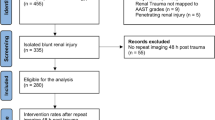Abstract
Purpose
Guidelines call for routine reimaging of Grade 4–5 renal injuries at 48–72 h. The aim of the current study is to evaluate the clinical utility of computed tomography (CT) reimaging in high-grade renal injuries.
Materials and methods
We assembled data on 216 trauma patients with high-grade renal trauma at three level 1 trauma centers over a 19-year span between 1999 and 2017 in retrospectively collected trauma database. Demographic, radiographic, and clinical characteristics of patients were retrospectively reviewed.
Results
In total, 151 cases were Grade 4 renal injuries, and 65 were Grade 5 renal injuries. 53.6% (81) Grade 4 and 15.4% (10) Grade 5 renal injuries were initially managed conservatively. Of the 6 asymptomatic cases where repeat imaging resulted in intervention, 100% had collecting system injuries at initial imaging. Collecting system injuries were only present in 42.9% of cases where routine repeat imaging did not trigger surgical intervention. Collecting system injury at the time of initial imaging was a statistically significant predictor of routine repeat imaging triggering surgical intervention (p = 0.022). Trauma grade and the presence of vascular injury were not significant predictors of intervention after repeat imaging in asymptomatic patients.
Conclusion
In asymptomatic patients with high-grade renal trauma, the number needed to image is approximately one in eight (12.5%) to identify need for surgical intervention. There is potentially room to improve criteria for routine renal imaging in high-grade renal trauma based on the more predictive imaging finding of collecting system injury.

Similar content being viewed by others
References
McAninch JW (1996) Renal injuries. In: Gillenwater JY, Grayhack JT, Howards SS, Duckett JW (eds) Adult and pediatric urology, 3rd edn. Mosby, St Louis, pp 539–553
Voelzke Bryan B, Leddy L (2014) The epidemiology of renal trauma. Transl Androl Urol 3.2:143–149 (PMC. Web. 12 June 2017)
Wessells H et al (2003) Renal injury and operative management in the United States: results of a population-based study. J Trauma 54.3:423–430
Moore E et al (1989) Organ injury scaling: spleen, liver, and kidney. J Trauma 29(12):1664–1666
Thall EH et al (1996) Conservative management of penetrating and blunt Type III renal injuries. Br J Urol 77(4):512–517
Bukur M, Inaba K, Barmparas G et al (2011) Routine follow-up imaging of kidney injuries may not be justified. J Trauma 70:1229
Breen KJ et al (2014) Adult blunt renal trauma: routine follow-up imaging is excessive. Urology 84.1:62–67
Cheng DL, Lazan D, Stone N (1994) Conservative treatment of type III renal trauma. J Trauma 36(4):491–494
Blankenship JC, Gavant ML, Cox CE et al (2001) Importance of delayed imaging for blunt renal trauma. World J Surg 25:1561
Shariat S et al (2008) Features and outcomes of patients with grade IV renal injury. BJU Int 102(6):728–733 (discussion 733)
Buckley J, Jack M (2006) Selective management of isolated and nonisolated grade IV renal injuries. J Urol 176(6):2498–2502 (discussion 2502)
Bonatti M et al (2015) MDCT of blunt renal trauma: imaging findings and therapeutic implications. Insights Imaging 6(2):261–272
Morey AF, Brandes S, Dugi DD et al (2014) Urotrauma: AUA guideline. J Urol 192(2):327–335. https://doi.org/10.1016/j.juro.2014.05.004
Davis P, Bultitude MF, Koukounaras J et al (2010) Assessing the usefulness of delayed imaging in routine followup for renal trauma. J Urol 184:973
May AM et al (2016) Successful nonoperative management of high-grade blunt renal injuries. Adv Urol 2016:3568076
Buckley Jill, McAninch Jack (2011) Revision of current American Association for the Surgery of Trauma Renal Injury grading system. J Trauma 70(1):35–37
McGuire J et al (2011) Predictors of outcome for blunt high grade renal injury treated with conservative intent. J Urol 185(1):187–191
Buckley Jill, McAninch Jack (2011) Revision of current American Association for the Surgery of Trauma Renal Injury grading system. J Trauma Injury Infect Crit Care 70(1):35–37
Gaither T et al (2018) Missed opportunities to decrease radiation exposure in children with renal trauma. J Urol 199(2):552–557
Author information
Authors and Affiliations
Contributions
DBB, MD, MPH: Protocol/project development, Data collection or management, Data analysis, Manuscript writing/editing. AT: Data collection or management, Manuscript writing/editing. NB, MD: Data collection or management, Data analysis, Manuscript writing/editing. GM, MD: Protocol/project development, Data collection or management, Data analysis, Manuscript writing/editing. ECO, MD: Protocol/project development, Data collection or management, Data analysis, Manuscript writing/editing. SO, MD: Data collection or management. JW: Data collection or management. LH, MD: Data analysis, Manuscript writing/editing. JM, MD: Protocol/project development, Data collection or management, Data analysis. BB, MD: Protocol/project development, Data collection or management, Data analysis, Manuscript writing/editing.
Corresponding author
Ethics declarations
Conflict of interest
The authors declare that they have no conflict of interest.
Research involving human participants and/or animals
All procedures performed in studies involving human participants were in accordance with the ethical standards of the institutional and/or national research committee and with the 1964 Helsinki declaration and its later amendments or comparable ethical standards.
Informed consent
This is a retrospective review. For this type of study formal consent is not required.
Rights and permissions
About this article
Cite this article
Bayne, D.B., Tresh, A., Baradaran, N. et al. Does routine repeat imaging change management in high-grade renal trauma? Results from three level 1 trauma centers. World J Urol 37, 1455–1459 (2019). https://doi.org/10.1007/s00345-018-2513-2
Received:
Accepted:
Published:
Issue Date:
DOI: https://doi.org/10.1007/s00345-018-2513-2




